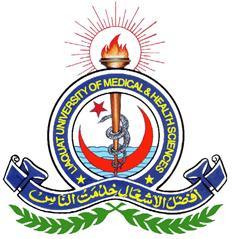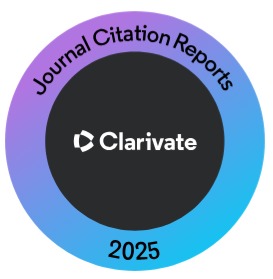Motor imagery promising technique for Rehabilitation of Patients with Parkinson's disease: A Systematic Review
Keywords:
Rehabilitation, Parkenson's disease , Motor imagery, systematic reviewAbstract
Recent research has suggested that motor imagery may be helpful for the Rehabilitation of Parkinson's disease (PD) patients. Using MI, a movement can be imagined without muscles being activated. MI induces plastic changes in the motor cortex, improving motor performance. This systematic review was designed to examine the effects of MI on the physical rehabilitation of people with Parkinson's disease. Five databases were used to identify similar studies using selected keywords. This review assessed the "methodological quality of each randomized control trial study" using the eleven-point Physiotherapy Evidence Database scale, widely used to rate physiotherapy "literature". The benefits of using MI to treat patients with PD were identified in this review. Seven studies were identified; 6 studies reported motor function, two studies worked on bradykinesia, two on balance and two reported impairments in Gait in PD using MI. The included studies had small samples, varied methodological approaches, and varied quality from good to fair. According to the current review, MI provides more significant benefits for Parkinson's patients than conventional physical therapy alone when used along with other therapeutic methods for improving motor function and balance.
Keywords: Rehabilitation, Parkinson's disease, Motor imagery, systematic review
References
Readman MR, Crawford TJ, Linkenauger SA, Bek J, Poliakoff E. Motor imagery vividness and symptom severity in Parkinson's disease. J Neuropsychology. 2023; 17(1): 180-92. doi: 10.1111/ jnp.12293.
Leiguarda R, Cerquetti D, Tenca E, Merello M. Globus pallidus internus firing rate modification after motor-imagination in three Parkinson's disease patients. J Neural Transm(Vienna). 2009; 116(4): 451-5. doi: 10.1007/s00702- 009-0203-3. Epub 2009 Mar 10.
Kober SE, Grössinger D, Wood G. Effects of motor imagery and visual neurofeedback on activation in the swallowing network: A real-time fMRI study. Dysphagia. 2019; 34(6): 879-95. doi: 10.1007/s00455-019-09985-w. Epub 2019 Feb 15.
Mizuguchi N, Kanosue K. Changes in brain activity during action observation and motor imagery: Their relationship with motor learning. Prog Brain Res. 2017; 234: 189-204. doi: 10.1016/bs.pbr.2017. 08.008. Epub 2017 Sep 14.
Hanakawa T. Organizing motor imageries. Neurosci Res. 2016; 104: 56-63. doi: 10.1016/ j.neures.2015.11.003. Epub 2015 Nov 19.
Abraham A, Duncan RP, Earhart GM. The Role of Mental Imagery in Parkinson's Disease Rehabilitation. Brain Sci. 2021; 11(2): 185. doi: 10.3390/brainsci11020185.
Lindsay RS, Larkin P, Kittel A, Spittle M. Mental imagery training programs for developing sport-specific motor skills: a systematic review and meta-analysis. Phys Educ Sport Pedagogy. 2023; 28(4): 444-65. doi: 10.1080/17408989. 2021.19911297.
Castillo-Rangel C, Marin G, Hernández-Contreras KA, Vichi-Ramírez MM, Zarate-Calderon C, Torres-Pineda O et al. Neuroinflammation in Parkinson's Disease: From Gene to Clinic: A Systematic Review. Int J Mol Sci. 2023; 24(6): 5792. doi: 10.3390/ijms24065792.
Heremans E, Smits-Engelsman B, Caeyenberghs K, Vercruysse S, Nieuwboer A, Feys P et al. Keeping an eye on imagery: the role of eye movements during motor imagery training. Neurosci. 2011; 195: 37-44. doi: 10.1016/neuro science2011.07.030.
Dickstein R, Deutsch JE. Motor imagery in physical therapist practice. Phys Ther. 2007; 87(7): 942-53. doi: 10.2522/ptj.20060331. Epub 2007 May 1.
Monaco MRL, Laudisio A, Fusco D, Vetrano DL, Ricciardi D, Zuccalà G et al. Laterality in Parkinson's disease may predict motor and visual imagery abilities. Funct Neurol. 2018; 33(2): 106-11.
Rochester L, Baker K, Hetherington V, Jones D, Willems AM, Kwakkel G et al. Evidence for motor learning in Parkinson's disease: acquisition, automaticity and retention of cued gait performance after training with external rhythmical cues. Brain Res. 2010; 1319: 103-11. doi: 10.1016/j.brainres.2010.01. 001. Epub 2010 Jan 11.
Di Iorio W, Ciarimboli A, Ferriero G, Feleppa M, Baratto L, Matarazzo G et al. Action Observation in People with Parkinson's Disease. A Motor–Cognitive Combined Approach for Motor Rehabilitation. A Preliminary Report. Diseases. 2018; 6(3): 58. doi: 10.3390/diseases6030058.
Bek J, Holmes PS, Craig CE, Franklin ZC, Sullivan M, Webb J et al. Action Imagery and Observation in Neurorehabilitation for Parkinson's Disease (ACTION-PD): development of a user-informed home training intervention to improve functional hand movements. Parkinson's Dis. 2021; 2021: 4559519. doi: 10.1155/2021/4559519.
Rabey JM, Korczyn AD. The Hoehn and Yahr Rating Scale for Parkinson's Disease. In: Przuntek, H., Kraus, P.H., Klotz, P., Korczyn, A.D. (eds) Instrumental Methods and Scoring in Extrapyramidal Disorders. Springer, Berlin, Heidelberg. https://doi.org/10.1007/978-3-642-78914-4_2.
de Morton NA. The PEDro scale is a valid measure of the methodological quality of clinical trials: a demographic study. Aust J Physiother. 2009; 55(2): 129-33. doi: 10.1016/s0004-9514(09)70043-1.
Maher CG, Sherrington C, Herbert RD, Moseley AM, Elkins M. Reliability of the PEDro scale for rating quality of randomized controlled trials. Phys Ther. 2003; 83(8): 713-21.
Braun S, Beurskens A, Kleynen M, Schols J, Wade D. Rehabilitation with mental practice has similar effects on mobility as rehabilitation with relaxation in people with Parkinson's disease: a multicentre randomised trial. J Physiother. 2011; 57(1): 27-34. doi: 10.1016/S1836-9553(11)70004-2.
Tamir R, Dickstein R, Huberman M. Integration of motor imagery and physical practice in group treatment applied to subjects with Parkinson's disease. Neurorehabil Neural Repair. 2007; 21(1): 68-75. doi: 10.1177/154596 8306292608.
Santiago LMdM, de Oliveira DA, de Macêdo Ferreira LGL, de Brito Pinto HY, Spaniol AP, de Lucena Trigueiro LC et al. Immediate effects of adding mental practice to physical practice on the Gait of individuals with Parkinson's disease: randomized clinical trial. NeuroRehabilitation. 2015; 37(2): 263-71. doi: 10.3233/NRE-151259.
Sarasso E, Agosta F, Piramide N, Gardoni A, Canu E, Leocadi M et al. Action Observation and Motor Imagery Improve Dual Task in Parkinson's Disease: A Clinical/fMRI Study. Mov Disord. 2021; 36(11): 2569-82.
Lokhandwala M, Kulkarni V, Nair M. Comparison of Combined Effects of Physical and Mental Practice with Physical Practice alone on Functional Independence in Parkinson (PD) Patients. Int J Physiother Res. 2019; 7: 3207-13. doi: 10.16965/ijpr.2019.160.
Abraham A, Hart A, Andrade I, Hackney ME. Dynamic neuro-cognitive imagery improves mental imagery ability, disease severity, and motor and cognitive functions in people with Parkinson's disease. Neural Plast. 2018; 2018: 6168507. doi: 10.1155/2018/6168507.
Bovend’Eerdt TJ, Dawes H, Sackley C, Wade DT. Practical research-based guidance for motor imagery practice in neurorehabilitation. Disabil Rehabil. 2012; 34(25): 2192-2200. doi: 10.3109/ 09638288.2012.676703. Epub 2012 Apr 25.
Nicholson V, Watts N, Chani Y, Keogh JW. Motor imagery training improves balance and mobility outcomes in older adults: a systematic review. J Physiother. 2019; 65(4): 200-207.
Jackson PL, Lafleur MF, Malouin F, Richards C, Doyon J. Potential role of mental practice using motor imagery in neurologic rehabilitation. Arch Phys Med Rehabil. 2001; 82(8): 1133-41. doi: 10.1053/ apmr.2001.24286.
Oostra KM. Mental Practice through motor imagery in gait rehabilitation following acquired brain injury. Thesis: Ghent University; 2016.
Gowda AS, Memon AN, Bidika E, Salib M, Rallabhandi B, Fayyaz H. Investigating the Viability of Motor Imagery as a Physical Rehabilitation Treatment for Patients With Stroke-Induced Motor Cortical Damage. Cureus. 2021; 13(3): e14001. doi: 10.7759/cureus.14001.
Anil K, Hall SD, Demain S, Freeman JA, Ganis G, Marsden J. A Systematic Review of Neurofeedback for the Management of Motor Symptoms in Parkinson's Disease. Brain Sci. 2021; 11(10): 1292.
Calvo A, Chiò A, Pagani M, Cammarosano S, Dematteis F, Moglia C et al. Parkinsonian traits in amyotrophic lateral sclerosis (ALS): a prospective population-based study. J Neurol. 2019; 266(7): 1633-42. doi: 10.1007/s00415- 019-09305-0. Epub 2019 Apr 4.
Abidi M, De Marco G, Grami F, Termoz N, Couillandre A, Querin G et al. Neural correlates of motor imagery of Gait in amyotrophic lateral sclerosis. J Magn Reson Imaging. 2021; 53(1): 223-33. doi: 10.1002/jmri.27335. Epub 2020 Sep 7.
Bae YH, Ko Y, Ha H, Ahn SY, Lee W, Lee SM. An efficacy study on improving balance and Gait in subacute stroke patients by balance training with additional motor imagery: a pilot study. J Phys Ther Sci. 2015; 27(10): 3245-8. doi: 10.1589/jpts.27.3245. Epub 2015 Oct 30.
Li RQ, Li ZM, Tan JY, Chen GL, Lin WY. Effects of motor imagery on walking function and balance in patients after stroke: A quantitative synthesis of randomized controlled trials. Complement Ther Clin Pract. 2017; 28: 75-84. doi: 10.1016/j.ctcp.2017.05.009. Epub 2017 May 26.
Woodrow-Hill C, Poliakoff E, Gowen E, Vogt S, Sullivan M. Can action observation and/or motor imagery be used to improve computer-based actions in people with Parkinson's? In BNA 2021 Festival of Neuroscience Poster abstracts. Vol. 5. Sage Publications Ltd. 2021. p. 235-236. (Brain and Neuroscience Advances). doi: 10.1177/2398 2128211035062.
Gil-Bermejo-Bernardez-Zerpa A, Moral-Munoz JA, Lucena-Anton D, Luque-Moreno C. Effectiveness of motor imagery on motor recovery in patients with multiple sclerosis: systematic review. Int J Environ Res Public Health. 2021; 18(2): 498. doi: 10.3390/ijerph18020498.
Moshref-Razavi S, Sohrabi M, Sotoodeh MS. Effect of neurofeedback interactions and mental imagery on the elderly's balance. Iran J Ageing. 2017; 12(3): 288-99. doi: 10.21859/sija.12.3.288.
Mirelman A, Rochester L, Maidan I, Del Din S, Alcock L, Nieuwhof F et al. Addition of a non-immersive virtual reality component to treadmill training to reduce fall risk in older adults (V-TIME): a randomised controlled trial. Lancet. 2016; 388(10050): 1170-82. doi: 10.1016/S0140-6736(16)31325-3. Epub 2016 Aug 11.
Avanzino L, Pelosin E, Martino D, Abbruzzese G. Motor timing deficits in sequential movements in Parkinson disease are related to action planning: a motor imagery study. PloS One. 2013; 8(9): e75454. doi: 10.1371/journal. pone.0075454.
Caligiore D, Mustile M, Spalletta G, Baldassarre G. Action observation and motor imagery for Rehabilitation in Parkinson's disease: A systematic review and an integrative hypothesis. Neurosci Biobehav Rev. 2017; 72: 210-22. doi: 10.1016/j.neubiorev.2016.11.005. Epub 2016 Nov 16.
Taube W, Mouthon M, Leukel C, Hoogewoud HM, Annoni JM, Keller M. Brain activity during observation and motor imagery of different balance tasks: an fMRI study. Cortex. 2015; 64: 102-14. doi: 10.1016/j.cortex.2014.09.022. Epub 2014 Oct 27.
Kim JY, Kim JM, Ko EY. The effect of the action observation physical training on the upper extremity function in children with cerebral palsy. J Exerc Rehabil. 2014; 10(3): 176-183. doi: 10.12965/jer.140114.
Sarasso E, Agosta F, Chiesi M, Piramide N, Canu E, Ravani I et al. Clinical and fMRI Effects of Action Observation and Motor Imagery Training on Dual-Task Performances in Parkinson's Disease Patients With Postural Instability and Gait Disorders (P5. 6-010). Neurology. 2019; 92(Suppl 15): P5.010.
Downloads
Published
How to Cite
Issue
Section
License
Copyright (c) 2023 Journal of Liaquat University of Medical & Health Sciences

This work is licensed under a Creative Commons Attribution-NonCommercial-ShareAlike 4.0 International License.
Submission of a manuscript to the journal implies that all authors have read and agreed to the content of the undertaking form or the Terms and Conditions.
When an article is accepted for publication, the author(s) retain the copyright and are required to grant the publisher the right of first publication and other non-exclusive publishing rights to JLUMHS.
Articles published in the Journal of Liaquat University of Medical & health sciences are open access articles under a Creative Commons Attribution-Noncommercial - Share Alike 4.0 License. This license permits use, distribution and reproduction in any medium; provided the original work is properly cited and initial publication in this journal. This is in accordance with the BOAI definition of open access. In addition to that users are allowed to remix, tweak and build upon the work non-commercially as long as appropriate credit is given and the new creations are licensed under the identical terms. Or, in certain cases it can be stated that all articles and content there in are published under creative commons license unless stated otherwise.























